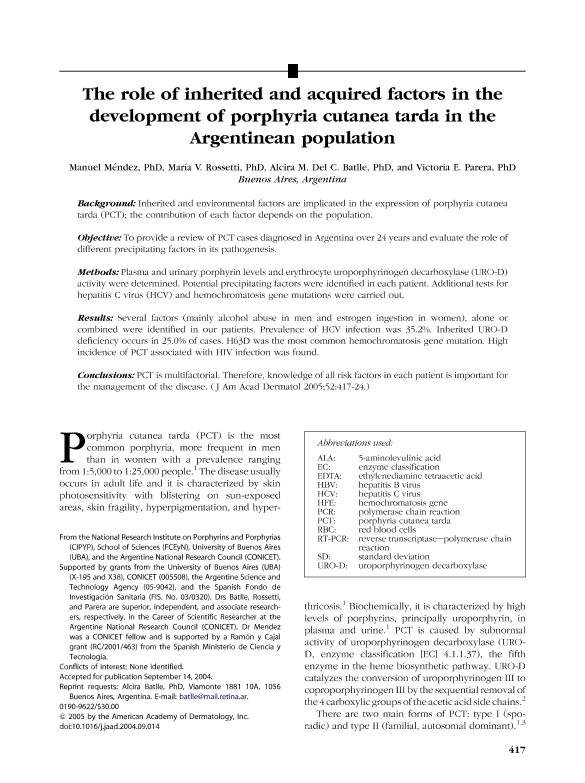Artículo
The role of inherited and acquired factors in the development of porphyria cutanea tarda in the Argentinean population
Fecha de publicación:
03/2005
Editorial:
Mosby-Elsevier
Revista:
Journal of the American Academy of Dermatology
ISSN:
0190-9622
Idioma:
Inglés
Tipo de recurso:
Artículo publicado
Clasificación temática:
Resumen
Background: Inherited and environmental factors are implicated in the expression of porphyria cutanea tarda (PCT); the contribution of each factor depends on the population.Inherited and environmental factors are implicated in the expression of porphyria cutanea tarda (PCT); the contribution of each factor depends on the population. Objective: To provide a review of PCT cases diagnosed in Argentina over 24 years and evaluate the role of different precipitating factors in its pathogenesis.To provide a review of PCT cases diagnosed in Argentina over 24 years and evaluate the role of different precipitating factors in its pathogenesis. Methods: Plasma and urinary porphyrin levels and erythrocyte uroporphyrinogen decarboxylase (URO-D) activity were determined. Potential precipitating factors were identified in each patient. Additional tests for hepatitis C virus (HCV) and hemochromatosis gene mutations were carried out.Plasma and urinary porphyrin levels and erythrocyte uroporphyrinogen decarboxylase (URO-D) activity were determined. Potential precipitating factors were identified in each patient. Additional tests for hepatitis C virus (HCV) and hemochromatosis gene mutations were carried out. Results: Several factors (mainly alcohol abuse in men and estrogen ingestion in women), alone or combined were identified in our patients. Prevalence of HCV infection was 35.2%. Inherited URO-D deficiency occurs in 25.0% of cases. H63D was the most common hemochromatosis gene mutation. High incidence of PCT associated with HIV infection was found. Conclusions: PCT is multifactorial. Therefore, knowledge of all risk factors in each patient is important for the management of the disease. ( J Am Acad Dermatol 2005;52:417-24.) combined were identified in our patients. Prevalence of HCV infection was 35.2%. Inherited URO-D deficiency occurs in 25.0% of cases. H63D was the most common hemochromatosis gene mutation. High incidence of PCT associated with HIV infection was found. Conclusions: PCT is multifactorial. Therefore, knowledge of all risk factors in each patient is important for the management of the disease. ( J Am Acad Dermatol 2005;52:417-24.) combined were identified in our patients. Prevalence of HCV infection was 35.2%. Inherited URO-D deficiency occurs in 25.0% of cases. H63D was the most common hemochromatosis gene mutation. High incidence of PCT associated with HIV infection was found. Conclusions: PCT is multifactorial. Therefore, knowledge of all risk factors in each patient is important for the management of the disease. ( J Am Acad Dermatol 2005;52:417-24.) combined were identified in our patients. Prevalence of HCV infection was 35.2%. Inherited URO-D deficiency occurs in 25.0% of cases. H63D was the most common hemochromatosis gene mutation. High incidence of PCT associated with HIV infection was found. Conclusions: PCT is multifactorial. Therefore, knowledge of all risk factors in each patient is important for the management of the disease. ( J Am Acad Dermatol 2005;52:417-24.) combined were identified in our patients. Prevalence of HCV infection was 35.2%. Inherited URO-D deficiency occurs in 25.0% of cases. H63D was the most common hemochromatosis gene mutation. High incidence of PCT associated with HIV infection was found. Conclusions: PCT is multifactorial. Therefore, knowledge of all risk factors in each patient is important for the management of the disease. ( J Am Acad Dermatol 2005;52:417-24.) combined were identified in our patients. Prevalence of HCV infection was 35.2%. Inherited URO-D deficiency occurs in 25.0% of cases. H63D was the most common hemochromatosis gene mutation. High incidence of PCT associated with HIV infection was found. Conclusions: PCT is multifactorial. Therefore, knowledge of all risk factors in each patient is important for the management of the disease. ( J Am Acad Dermatol 2005;52:417-24.) combined were identified in our patients. Prevalence of HCV infection was 35.2%. Inherited URO-D deficiency occurs in 25.0% of cases. H63D was the most common hemochromatosis gene mutation. High incidence of PCT associated with HIV infection was found. Conclusions: PCT is multifactorial. Therefore, knowledge of all risk factors in each patient is important for the management of the disease. ( J Am Acad Dermatol 2005;52:417-24.) combined were identified in our patients. Prevalence of HCV infection was 35.2%. Inherited URO-D deficiency occurs in 25.0% of cases. H63D was the most common hemochromatosis gene mutation. High incidence of PCT associated with HIV infection was found. Conclusions: PCT is multifactorial. Therefore, knowledge of all risk factors in each patient is important for the management of the disease. ( J Am Acad Dermatol 2005;52:417-24.) combined were identified in our patients. Prevalence of HCV infection was 35.2%. Inherited URO-D deficiency occurs in 25.0% of cases. H63D was the most common hemochromatosis gene mutation. High incidence of PCT associated with HIV infection was found. Conclusions: PCT is multifactorial. Therefore, knowledge of all risk factors in each patient is important for the management of the disease. ( J Am Acad Dermatol 2005;52:417-24.) Several factors (mainly alcohol abuse in men and estrogen ingestion in women), alone or combined were identified in our patients. Prevalence of HCV infection was 35.2%. Inherited URO-D deficiency occurs in 25.0% of cases. H63D was the most common hemochromatosis gene mutation. High incidence of PCT associated with HIV infection was found. Conclusions: PCT is multifactorial. Therefore, knowledge of all risk factors in each patient is important for the management of the disease. ( J Am Acad Dermatol 2005;52:417-24.)Conclusions: PCT is multifactorial. Therefore, knowledge of all risk factors in each patient is important for the management of the disease. ( J Am Acad Dermatol 2005;52:417-24.)
Archivos asociados
Licencia
Identificadores
Colecciones
Articulos(CIPYP)
Articulos de CENTRO DE INVEST. SOBRE PORFIRINAS Y PORFIRIAS
Articulos de CENTRO DE INVEST. SOBRE PORFIRINAS Y PORFIRIAS
Citación
Méndez, Manuel; Rossetti, Maria Victoria; Batlle, Alcira María del C.; Parera, Victoria Estela; The role of inherited and acquired factors in the development of porphyria cutanea tarda in the Argentinean population; Mosby-Elsevier; Journal of the American Academy of Dermatology; 52; 3 Pt 1; 3-2005; 417-424
Compartir
Altmétricas




